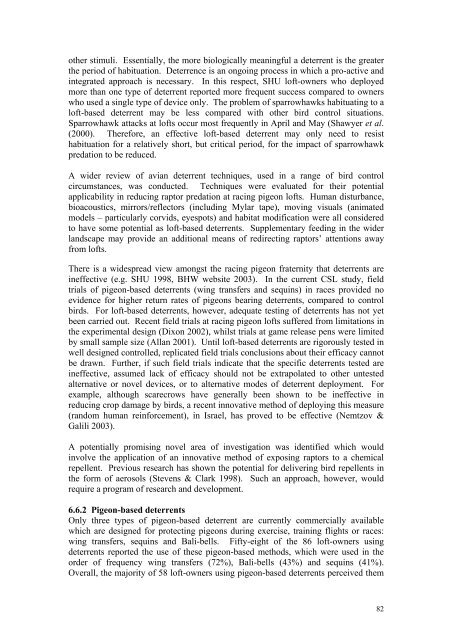RACING PIGEONS â IMPACT OF RAPTOR PREDATION
RACING PIGEONS â IMPACT OF RAPTOR PREDATION
RACING PIGEONS â IMPACT OF RAPTOR PREDATION
You also want an ePaper? Increase the reach of your titles
YUMPU automatically turns print PDFs into web optimized ePapers that Google loves.
other stimuli. Essentially, the more biologically meaningful a deterrent is the greater<br />
the period of habituation. Deterrence is an ongoing process in which a pro-active and<br />
integrated approach is necessary. In this respect, SHU loft-owners who deployed<br />
more than one type of deterrent reported more frequent success compared to owners<br />
who used a single type of device only. The problem of sparrowhawks habituating to a<br />
loft-based deterrent may be less compared with other bird control situations.<br />
Sparrowhawk attacks at lofts occur most frequently in April and May (Shawyer et al.<br />
(2000). Therefore, an effective loft-based deterrent may only need to resist<br />
habituation for a relatively short, but critical period, for the impact of sparrowhawk<br />
predation to be reduced.<br />
A wider review of avian deterrent techniques, used in a range of bird control<br />
circumstances, was conducted. Techniques were evaluated for their potential<br />
applicability in reducing raptor predation at racing pigeon lofts. Human disturbance,<br />
bioacoustics, mirrors/reflectors (including Mylar tape), moving visuals (animated<br />
models – particularly corvids, eyespots) and habitat modification were all considered<br />
to have some potential as loft-based deterrents. Supplementary feeding in the wider<br />
landscape may provide an additional means of redirecting raptors’ attentions away<br />
from lofts.<br />
There is a widespread view amongst the racing pigeon fraternity that deterrents are<br />
ineffective (e.g. SHU 1998, BHW website 2003). In the current CSL study, field<br />
trials of pigeon-based deterrents (wing transfers and sequins) in races provided no<br />
evidence for higher return rates of pigeons bearing deterrents, compared to control<br />
birds. For loft-based deterrents, however, adequate testing of deterrents has not yet<br />
been carried out. Recent field trials at racing pigeon lofts suffered from limitations in<br />
the experimental design (Dixon 2002), whilst trials at game release pens were limited<br />
by small sample size (Allan 2001). Until loft-based deterrents are rigorously tested in<br />
well designed controlled, replicated field trials conclusions about their efficacy cannot<br />
be drawn. Further, if such field trials indicate that the specific deterrents tested are<br />
ineffective, assumed lack of efficacy should not be extrapolated to other untested<br />
alternative or novel devices, or to alternative modes of deterrent deployment. For<br />
example, although scarecrows have generally been shown to be ineffective in<br />
reducing crop damage by birds, a recent innovative method of deploying this measure<br />
(random human reinforcement), in Israel, has proved to be effective (Nemtzov &<br />
Galili 2003).<br />
A potentially promising novel area of investigation was identified which would<br />
involve the application of an innovative method of exposing raptors to a chemical<br />
repellent. Previous research has shown the potential for delivering bird repellents in<br />
the form of aerosols (Stevens & Clark 1998). Such an approach, however, would<br />
require a program of research and development.<br />
6.6.2 Pigeon-based deterrents<br />
Only three types of pigeon-based deterrent are currently commercially available<br />
which are designed for protecting pigeons during exercise, training flights or races:<br />
wing transfers, sequins and Bali-bells. Fifty-eight of the 86 loft-owners using<br />
deterrents reported the use of these pigeon-based methods, which were used in the<br />
order of frequency wing transfers (72%), Bali-bells (43%) and sequins (41%).<br />
Overall, the majority of 58 loft-owners using pigeon-based deterrents perceived them<br />
82
















